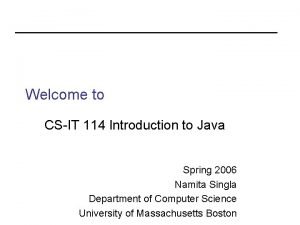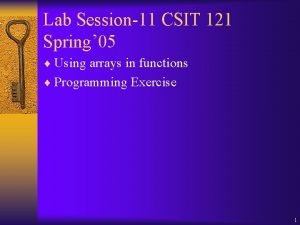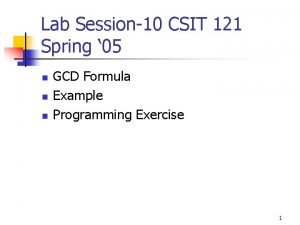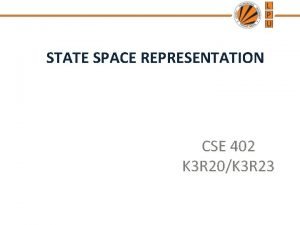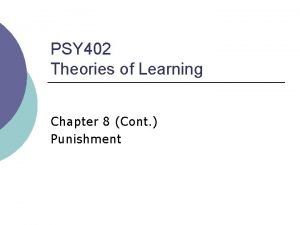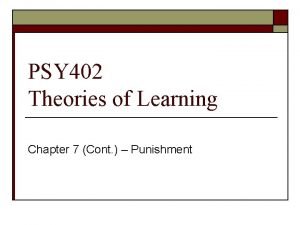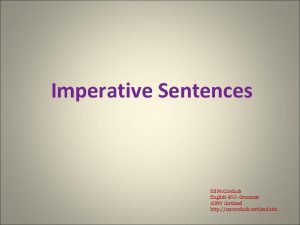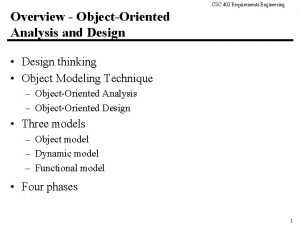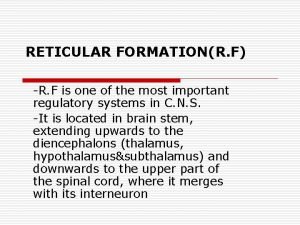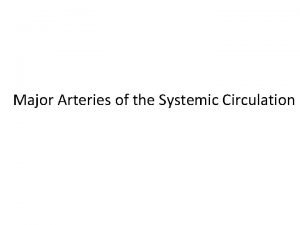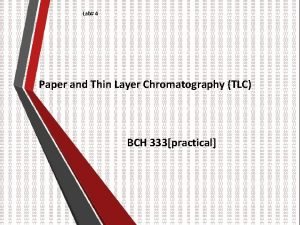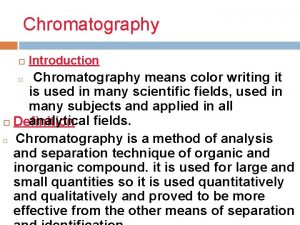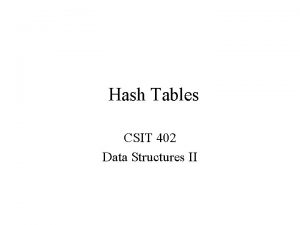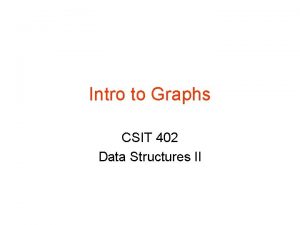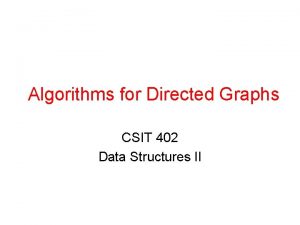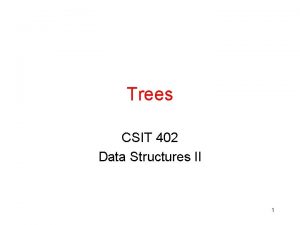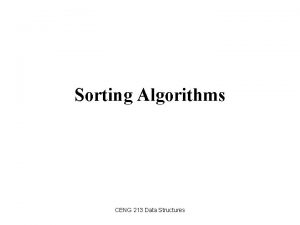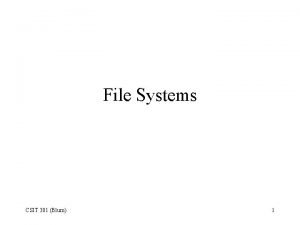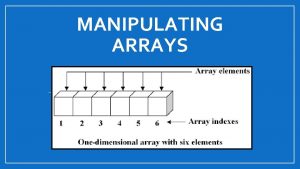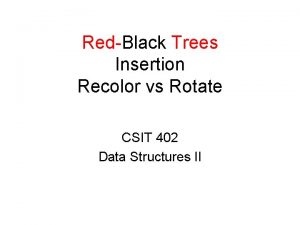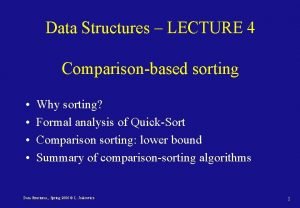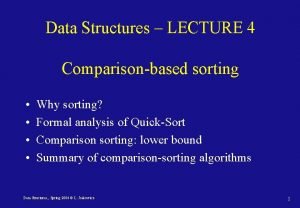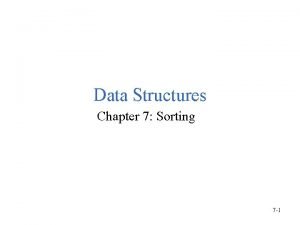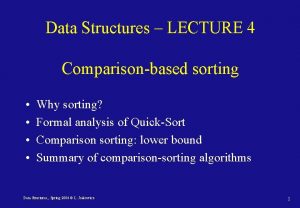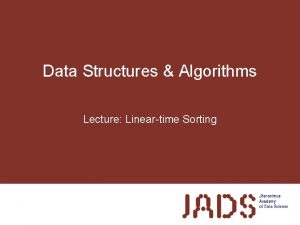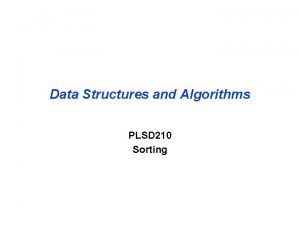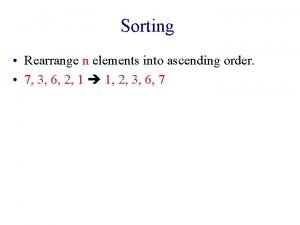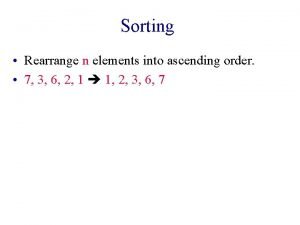Sorting CSIT 402 Data Structures II Sorting Ascending






![Bubblesort bubble(A[1. . n]: integer array, n : integer): { i, j : integer; Bubblesort bubble(A[1. . n]: integer array, n : integer): { i, j : integer;](https://slidetodoc.com/presentation_image_h/9d4ebff1151641ea7f782878a9829762/image-7.jpg)




![Insertion Sort Insertion. Sort(A[1. . N]: integer array, N: integer) { i, j, temp: Insertion Sort Insertion. Sort(A[1. . N]: integer array, N: integer) { i, j, temp:](https://slidetodoc.com/presentation_image_h/9d4ebff1151641ea7f782878a9829762/image-12.jpg)

![Heap Sort • • We use a Max-Heap Root node = A[0] Children of Heap Sort • • We use a Max-Heap Root node = A[0] Children of](https://slidetodoc.com/presentation_image_h/9d4ebff1151641ea7f782878a9829762/image-14.jpg)











![Merging Algorithm Merge(A[], T[] : integer array, left, right : integer) : { mid, Merging Algorithm Merge(A[], T[] : integer array, left, right : integer) : { mid,](https://slidetodoc.com/presentation_image_h/9d4ebff1151641ea7f782878a9829762/image-26.jpg)
![Recursive Mergesort(A[], T[] : integer array, left, right : integer) : { if left Recursive Mergesort(A[], T[] : integer array, left, right : integer) : { if left](https://slidetodoc.com/presentation_image_h/9d4ebff1151641ea7f782878a9829762/image-27.jpg)


![Iterative Mergesort Iterative. Mergesort(A[1. . n]: integer array, n : integer) : { //precondition: Iterative Mergesort Iterative. Mergesort(A[1. . n]: integer array, n : integer) : { //precondition:](https://slidetodoc.com/presentation_image_h/9d4ebff1151641ea7f782878a9829762/image-30.jpg)












![Recursive Quicksort(A[]: integer array, left, right : integer): { pivotindex : integer; if left Recursive Quicksort(A[]: integer array, left, right : integer): { pivotindex : integer; if left](https://slidetodoc.com/presentation_image_h/9d4ebff1151641ea7f782878a9829762/image-43.jpg)




- Slides: 47

Sorting CSIT 402 Data Structures II

Sorting (Ascending Order) • Input › an array A of data records › a key value in each data record › a comparison function which imposes a consistent ordering on the keys (e. g. , integers) • Output › reorganize the elements of A such that • For any i and j, if i < j then A[i] A[j] 2

Space • How much space does the sorting algorithm require in order to sort the collection of items? › › Is copying needed? O(n) time to accomplish In-place sorting – no copying – O(1) time Somewhere in between for “temporary”, space External memory sorting – data so large that does not fit in memory 3

Time • How fast is the algorithm? › The definition of a sorted array A says that for any i<j, A[i] < A[j] › This means that you need to at least check on each element at the very minimum, I. e. , at least O(N) › And you could end up checking each element against every other element, which is O(N 2) › The big question is: How close to O(N) can you get? 4

Stability • Stability: Does it rearrange the order of input data records which have the same key value (duplicates)? › E. g. Phone book sorted by name. Now sort by county – is the list still sorted by name within each county? › Extremely important property for databases › A stable sorting algorithm is one which does not rearrange the order of duplicate keys 5

Bubble Sort • “Bubble” elements to to their proper place in the array by comparing elements i and i+1, and swapping if A[i] > A[i+1] › Bubble every element towards its correct position • last position has the largest element • then bubble every element except the last one towards its correct position • then repeat until done or until the end of the quarter, whichever comes first. . . 6
![Bubblesort bubbleA1 n integer array n integer i j integer Bubblesort bubble(A[1. . n]: integer array, n : integer): { i, j : integer;](https://slidetodoc.com/presentation_image_h/9d4ebff1151641ea7f782878a9829762/image-7.jpg)
Bubblesort bubble(A[1. . n]: integer array, n : integer): { i, j : integer; for i = 1 to n-1 do for j = 2 to n–i+1 do if A[j-1] > A[j] then SWAP(A[j-1], A[j]); } SWAP(a, b) : { t : integer; 6 t: =a; a: =b; b: =t; } 1 2 3 4 5 6 6 5 3 2 7 1 5 6 3 2 7 1 5 3 6 2 7 1 7

Put the largest element in its place larger value? 2 3 8 8 1 2 3 8 7 swap 9 10 12 23 18 15 16 17 14 1 2 3 7 8 9 10 12 23 18 15 16 17 14 14 9 10 12 23 23 1 2 3 7 8 9 10 12 23 18 swap 1 2 3 7 8 9 10 12 18 23 15 swap 1 2 3 7 8 9 10 12 18 15 23 16 swap 1 2 3 7 8 9 10 12 18 15 16 23 17 swap 1 2 3 7 8 9 10 12 18 15 16 17 23 14 swap 1 2 3 7 8 9 10 12 18 15 16 17 14 23 8

Put 2 nd largest element in its place larger value? 2 3 7 9 8 10 12 18 18 1 2 3 7 8 9 10 12 18 15 swap 16 17 14 23 1 2 3 7 8 9 10 12 15 18 16 swap 17 14 23 1 2 3 7 8 9 10 12 15 16 18 17 swap 14 23 1 2 3 7 8 9 10 12 15 16 17 18 14 swap 23 1 2 3 7 8 9 10 12 15 16 17 14 23 18 Two elements done, only n-2 more to go. . . 9

Bubble Sort: Just Say No • “Bubble” elements to to their proper place in the array by comparing elements i and i+1, and swapping if A[i] > A[i+1] • We bubblize for i=1 to n (i. e, n times) • Each bubblization is a loop that makes n-i comparisons • This is O(n 2) 10

Insertion Sort • What if first k elements of array are already sorted? › 4, 7, 12, 5, 19, 16 • We can shift the tail of the sorted elements list down and then insert next element into proper position and we get k+1 sorted elements › 4, 5, 7, 12, 19, 16 11
![Insertion Sort Insertion SortA1 N integer array N integer i j temp Insertion Sort Insertion. Sort(A[1. . N]: integer array, N: integer) { i, j, temp:](https://slidetodoc.com/presentation_image_h/9d4ebff1151641ea7f782878a9829762/image-12.jpg)
Insertion Sort Insertion. Sort(A[1. . N]: integer array, N: integer) { i, j, temp: integer ; for i = 2 to N { temp : = A[i]; j : = i; while j > 1 and A[j-1] > temp { A[j] : = A[j-1]; j : = j– 1; } A[j] = temp; 1 2 3 } 2 1 4 } • Is Insertion sort in place? • Running time = ? i j 12

Insertion Sort Characteristics • In place and Stable • Running time › Worst case is O(N 2) • reverse order input • must copy every element every time • Good sorting algorithm for almost sorted data › Each item is close to where it belongs in sorted order. 13
![Heap Sort We use a MaxHeap Root node A0 Children of Heap Sort • • We use a Max-Heap Root node = A[0] Children of](https://slidetodoc.com/presentation_image_h/9d4ebff1151641ea7f782878a9829762/image-14.jpg)
Heap Sort • • We use a Max-Heap Root node = A[0] Children of A[i] = A[2 i+1], A[2 i+2] Keep track of current size N (number of nodes) value 7 5 6 2 4 index 0 1 2 3 4 7 5 5 6 7 2 6 4 N=5 14

Using Binary Heaps for Sorting • Build a max-heap • Do N Delete. Max operations and store each Max element as it comes out of the heap • Data comes out in largest to smallest order • Where can we put the elements as they are removed from the heap? 7 Build Max-heap 5 2 6 4 Delete. Max 6 5 2 4 7 15

1 Removal = 1 Addition • Every time we do a Delete. Max, the heap gets smaller by one node, and we have one more node to store › Store the data at the end of the heap array › Not "in the heap" but it is in the heap array 6 value 6 5 4 2 7 index 1 2 3 4 5 N=4 5 6 7 8 2 4 7 16

Repeated Delete. Max 5 5 2 4 6 7 1 2 3 4 5 2 6 7 8 N=3 6 4 7 4 4 2 5 6 7 1 2 3 4 5 N=2 2 6 7 8 6 5 7 17

Heap Sort is In-place • After all the Delete. Max operations, the heap is gone but the array is full and sorted 2 value 2 4 5 6 7 index 1 2 3 4 5 4 6 7 8 N=0 6 5 7 Note that you get the last element ‘for free’ 18

Heapsort: Analysis • Running time › time to build max-heap is O(N) › time for N Delete. Max operations is N O(log N) › total time is O(N+N log N) = O(N log N) • Can also show that running time is (N log N) for some inputs, › so worst case is (N log N) › Average case running time is also O(N log N) • Heapsort is in-place but not stable (why? ) 19

“Divide and Conquer” • Very important strategy in computer science: › Divide problem into smaller parts › Independently solve the parts › Combine these solutions to get overall solution • Idea 1: Divide array into two halves, recursively sort left and right halves, then merge two halves Mergesort • Idea 2 : Partition array into items that are “small” and items that are “large”, then recursively sort the two sets Quicksort 20

Mergesort 8 2 9 4 5 3 1 6 • Divide it in two at the midpoint • Conquer each side in turn (by recursively sorting) • Merge two halves together 21

Mergesort Example 8 Divide 8 2 Divide 1 element 8 2 Merge 9 4 5 3 8 2 9 4 9 2 4 8 9 Merge 6 1 6 5 3 4 4 1 5 3 1 6 9 4 2 8 Merge 2 9 5 3 1 3 5 6 1 2 3 4 5 6 8 9 22

Auxiliary Array • The merging requires an auxiliary array. 2 4 8 9 1 3 5 6 Auxiliary array 23

Auxiliary Array • The merging requires an auxiliary array. 2 1 4 8 9 1 3 5 6 Auxiliary array 24

Auxiliary Array • The merging requires an auxiliary array. 2 4 8 9 1 1 2 3 4 5 3 5 6 Auxiliary array 25
![Merging Algorithm MergeA T integer array left right integer mid Merging Algorithm Merge(A[], T[] : integer array, left, right : integer) : { mid,](https://slidetodoc.com/presentation_image_h/9d4ebff1151641ea7f782878a9829762/image-26.jpg)
Merging Algorithm Merge(A[], T[] : integer array, left, right : integer) : { mid, i, j, k, l, target : integer; mid : = (right + left)/2; i : = left; j : = mid + 1; target : = left; while i < mid and j < right do if A[i] < A[j] then T[target] : = A[i] ; i: = i + 1; else T[target] : = A[j]; j : = j + 1; target : = target + 1; if i > mid then //left completed// for k : = left to target-1 do A[k] : = T[k]; if j > right then //right completed// k : = mid; l : = right; while k > i do A[l] : = A[k]; k : = k-1; l : = l-1; for k : = left to target-1 do A[k] : = T[k]; } 26
![Recursive MergesortA T integer array left right integer if left Recursive Mergesort(A[], T[] : integer array, left, right : integer) : { if left](https://slidetodoc.com/presentation_image_h/9d4ebff1151641ea7f782878a9829762/image-27.jpg)
Recursive Mergesort(A[], T[] : integer array, left, right : integer) : { if left < right then mid : = (left + right)/2; Mergesort(A, T, left, mid); Mergesort(A, T, mid+1, right); Merge(A, T, left, right); } Main. Mergesort(A[1. . n]: integer array, n : integer) : { T[1. . n]: integer array; Mergesort[A, T, 1, n]; } 27

Iterative Mergesort uses 2 arrays; alternates between them Merge by 1 Merge by 2 Merge by 4 Merge by 8 28

Iterative Mergesort Merge by 1 Merge by 2 Merge by 4 Merge by 8 Merge by 16 Need of a last copy 29
![Iterative Mergesort Iterative MergesortA1 n integer array n integer precondition Iterative Mergesort Iterative. Mergesort(A[1. . n]: integer array, n : integer) : { //precondition:](https://slidetodoc.com/presentation_image_h/9d4ebff1151641ea7f782878a9829762/image-30.jpg)
Iterative Mergesort Iterative. Mergesort(A[1. . n]: integer array, n : integer) : { //precondition: n is a power of 2// i, m, parity : integer; T[1. . n]: integer array; m : = 2; parity : = 0; while m < n do for i = 1 to n – m + 1 by m do if parity = 0 then Merge(A, T, i, i+m-1); else Merge(T, A, i, i+m-1); parity : = 1 – parity; m : = 2*m; if parity = 1 then for i = 1 to n do A[i] : = T[i]; } How do you handle non-powers of 2? How can the final copy be avoided? 30

Mergesort Analysis • Let T(N) be the running time for an array of N elements • Mergesort divides array in half and calls itself on the two halves. After returning, it merges both halves using a temporary array • Each recursive call takes T(N/2) and merging takes O(N) 31

Properties of Mergesort • Not in-place › Requires an auxiliary array (O(n) extra space) • Stable › Only if left is sent to target on equal values. • Iterative Mergesort reduces copying. 32

Quicksort • Quicksort uses a divide and conquer strategy, but does not require the O(N) extra space that Merge. Sort does › Partition array into left and right sub-arrays • Choose an element of the array, called pivot • the elements in left sub-array are all less than pivot • elements in right sub-array are all greater than pivot › Recursively sort left and right sub-arrays › Concatenate left and right sub-arrays in O(1) time 33

“Four easy steps” • To sort an array S 1. If the number of elements in S is 0 or 1, then return. The array is sorted. 2. Pick an element v in S. This is the pivot value. 3. Partition S-{v} into two disjoint subsets, S 1 = {all values x v}, and S 2 = {all values x v}. 4. Return Quick. Sort(S 1), v, Quick. Sort(S 2) 34

The steps of Quick. Sort S 81 13 31 43 select pivot value 57 75 92 26 65 S 1 0 13 26 31 43 S 2 0 partition S 75 65 81 92 57 S 1 Quick. Sort(S 1) and Quick. Sort(S 2) S 2 0 13 26 31 43 57 75 65 81 92 After partitioning until obtaining subsets of size 1 S 0 13 26 31 43 57 65 75 81 92 [Weiss] Voila! S is sorted 35

Details, details • Implementing the actual partitioning • Picking the pivot › want a value that will cause |S 1| and |S 2| to be non-zero, and close to equal in size if possible • Dealing with cases where the element equals the pivot 36

Quicksort Partitioning • Need to partition the array into left and right subarrays › the elements in left sub-array are pivot › elements in right sub-array are pivot • How do the elements get to the correct partition? › Choose an element from the array as the pivot › Make one pass through the rest of the array and swap as needed to put elements in partitions 37

Partitioning: Choosing the pivot • One implementation (there are others) › median 3 finds pivot and sorts left, center, right • • • Median 3 takes the median of leftmost, middle, and rightmost elements An alternative is to choose the pivot randomly (need a random number generator; “expensive”) Another alternative is to choose the first element (but can be very bad. Why? ) › Swap pivot with next to last element 38

Partitioning in-place › › › Set pointers i and j to start and end of array Increment i until you hit element A[i] > pivot Decrement j until you hit elmt A[j] < pivot Swap A[i] and A[j] Repeat until i and j cross Swap pivot (at A[N-2]) with A[i] 39

Example Choose the pivot as the median of three 0 1 2 3 4 5 6 7 8 9 8 1 4 9 0 3 5 2 7 6 Median of 0, 6, 8 is 6. Pivot is 6 0 i 1 4 9 7 3 5 2 6 8 j Place the largest at the right and the smallest at the left. Swap pivot with next to last element. 40

Example i 0 j 1 4 9 7 3 5 2 i 0 1 4 9 7 3 5 1 4 2 2 6 8 6 8 j 7 3 5 i 0 8 j i 0 6 2 j 7 3 5 9 Move i to the right up to A[i] larger than pivot. Move j to the left up to A[j] smaller than pivot. Swap 41

Example i 0 1 4 2 7 j 3 5 i 0 1 4 2 7 1 4 2 5 6 8 9 6 8 9 7 8 j 3 5 i 0 9 j 3 7 i j 0 0 0 1 1 1 4 4 4 2 2 2 S 1 < pivot 5 5 5 3 7 j i 3 6 pivot S 2 > pivot Cross-over i > j 42
![Recursive QuicksortA integer array left right integer pivotindex integer if left Recursive Quicksort(A[]: integer array, left, right : integer): { pivotindex : integer; if left](https://slidetodoc.com/presentation_image_h/9d4ebff1151641ea7f782878a9829762/image-43.jpg)
Recursive Quicksort(A[]: integer array, left, right : integer): { pivotindex : integer; if left + CUTOFF right then pivot : = median 3(A, left, right); pivotindex : = Partition(A, left, right-1, pivot); Quicksort(A, left, pivotindex – 1); Quicksort(A, pivotindex + 1, right); else Insertionsort(A, left, right); } Don’t use quicksort for small arrays. CUTOFF = 10 is reasonable. 43

Quicksort Best Case Performance • Algorithm always chooses best pivot and splits sub-arrays in half at each recursion › T(0) = T(1) = O(1) • constant time if 0 or 1 element › For N > 1, 2 recursive calls plus linear time for partitioning › T(N) = 2 T(N/2) + O(N) • Same recurrence relation as Mergesort › T(N) = O(N log N) 44

Quicksort Worst Case Performance • Algorithm always chooses the worst pivot – one sub-array is empty at each recursion › T(N) a for N C › T(N) T(N-1) + b. N › T(N-2) + b(N-1) + b. N › T(C) + b(C+1)+ … + b. N › a +b(C + (C+1) + (C+2) + … + N) › T(N) = O(N 2) • Fortunately, average case performance is O(N log N) (see text for proof) 45

Properties of Quicksort • • Not stable because of long distance swapping. No iterative version (without using a stack). Pure quicksort not good for small arrays. “In-place”, but uses auxiliary storage because of recursive call (O(logn) space). • O(n log n) average case performance, but O(n 2) worst case performance. 46

Folklore • “Quicksort is the best in-memory sorting algorithm. ” • Truth › Quicksort uses very few comparisons on average. › Quicksort does have good performance in the memory hierarchy. • Small footprint • Good locality 47
 What is internal and external sorting
What is internal and external sorting Csit114
Csit114 Dr junaid ahmed
Dr junaid ahmed Cd csit
Cd csit Csit 121
Csit 121 Csit 121
Csit 121 Csit 121
Csit 121 Cse 402
Cse 402 401 stitch type
401 stitch type Isae 3000 vs 3402
Isae 3000 vs 3402 Ist 402
Ist 402 Ist 402
Ist 402 8884026916
8884026916 Tca 55-10-416
Tca 55-10-416 Ist 402
Ist 402 Quantas prendas a turma 403 já levou para a escola
Quantas prendas a turma 403 já levou para a escola Soc 402
Soc 402 Soc 402
Soc 402 Novacat 402
Novacat 402 Ist 402
Ist 402 Test av kontroller revisjon
Test av kontroller revisjon Dev-402
Dev-402 402
402 Ist 402
Ist 402 Prijs de vader prijs de zoon
Prijs de vader prijs de zoon English 402
English 402 402
402 Cont 402
Cont 402 Cont 402
Cont 402 Diagramming interrogative sentences
Diagramming interrogative sentences Ist 402
Ist 402 Ist 402
Ist 402 Csc402
Csc402 Ce 402
Ce 402 How are the whale flipper and the human arm different
How are the whale flipper and the human arm different Spinothalamic tract
Spinothalamic tract Loop of henle function
Loop of henle function Reticular activating system
Reticular activating system Major arteries of the ascending aorta and aortic arch
Major arteries of the ascending aorta and aortic arch Ascending levels of intellectual demand
Ascending levels of intellectual demand Appendix venous drainage
Appendix venous drainage Difference between ascending and descending chromatography
Difference between ascending and descending chromatography Descending
Descending Hasselbalch equation
Hasselbalch equation Ascending christology definition
Ascending christology definition Ascending chromatography
Ascending chromatography Chromatography biochemistry
Chromatography biochemistry Auditory
Auditory

